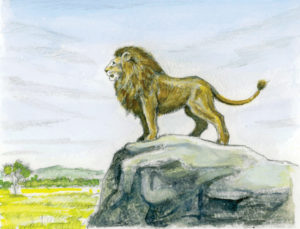This installment, published in the June 19, 2019, issue of the Seikyo Shimbun, focuses on passages from Nichiren Daishonin’s writings that SGI President Ikeda discussed in volume 9 of The New Human Revolution.
Passage 1
“Regard your service to your lord as the practice of the Lotus Sutra.” (“Reply to a Believer,” The Writings of Nichiren Daishonin, vol. 1, p. 905)
Show Actual Proof at Work

Illustration courtesy of Seikyo Press.
In his novel, SGI President Ikeda examines the driving force behind Japan’s rapid economic growth after World War II, noting that it coincided with the tremendous development of the Soka Gakkai.
Hard work and diligence have traditionally been regarded as virtues of the Japanese people, but after the war there also came a time when that awareness started to fade. In particular, as people began to identify with one or other of the opposing camps of capitalists or laborers, the eagerness of the latter camp to work began to decline.
Soka Gakkai members, however, were cultivating a view of work as not just a means of earning a living, but as a way to polish themselves as human beings. This was based on Nichiren Daishonin’s teaching: “Regard your service to your lord as the practice of the Lotus Sutra” (WND-1, 905). “Service to your lord” here refers to one’s occupation. In other words, the Daishonin is telling us to regard our work as our practice of Buddhism.
Second Soka Gakkai President Josei Toda always said that as Soka Gakkai members, in order to become indispensable people at work and win the trust of our colleagues, we need to have the faith of one, and work as hard as three.
Nichiren Buddhism is a teaching that aims for the realization of happiness for both oneself and others, and the goal of the Soka Gakkai is the simultaneous achievement of social prosperity and individual happiness. Toward that end, the Soka Gakkai members in postwar Japan strove to contribute to society, to improve themselves through their work and to show actual proof at their workplace. Their philosophy and the pride and commitment they felt as Buddhists motivated them to work hard. (The New Human Revolution, vol. 9, pp. 272–73)
Passage 2
“When an evil ruler in consort with priests of erroneous teachings tries to destroy the correct teaching and do away with a man of wisdom, those with the heart of a lion king are sure to attain Buddhahood.” (“Letter From Sado,” WND-1, 302)
The Joint Struggle of Independent Lions

Illustration courtesy of Seikyo Press.
The high school division was established in 1964, and 1966 was set as “The Year of the High School Division.” At the start of the year, Shin’ichi Yamamoto began pouring his energies into giving lectures on the writings of Nichiren Daishonin to representatives of the high school division, successors of the Soka Gakkai.
Political authorities and religious groups will join forces solely out of their hatred for the Soka Gakkai and launch attacks on us. But a lion king is one who stands up, even alone, to carry out the mission of kosen-rufu with tremendous courage.
“After [first Soka Gakkai President Tsunesaburo] Makiguchi’s death, [Josei] Toda took on the challenge of kosen-rufu by himself. That is the Gakkai spirit and the way fellow members should live their lives. If that spirit is lost, we will be nothing but a disorderly crowd. True unity is not a group of cowardly people leaning up against one another. It is the joint struggle of independent lions.”
Shin’ichi’s words were strict, as if he were giving guidance to the Soka Gakkai’s top leaders.
■ ■ ■
“You must also never become a worm inside the lion’s body yourselves, nor allow your friends gathered here today to become one either …
“I hope that as long as you live you will never forget that the Soka Gakkai spirit is the pure spirit that leads to kosen-rufu. And I hope you will share it with younger members as well. At any rate, I entrust the future of kosen-rufu to you.” (NHR-9, 145–46)
Kosen-rufu Is an Earnest, All-Out Challenge That We Must Win
In the “Young Phoenixes” chapter, at the Tokyo Metropolitan High School Division meeting, Shin’ichi Yamamoto talks about Yu Kwan Sun, a 16-year-old student who stood up against Japan’s colonial rule over Korea. She led the movement for her nation’s independence, often crying out: “Long live independence!”
A student at Ewha Academy (now Ewha Womans University) some 100 years ago in 1919, Yu Kwan Sun took a hiatus from school to return to her hometown to fight for the national independence movement. After returning to her village, she visited one person after another, conveying the importance of the independence movement. The people of her village rose into action by organizing demonstrations. As a result, they were heavily suppressed by Japanese colonial powers.
She was arrested, and her life came to an end in prison. She later came to be known as the “Korean Joan of Arc” for dedicating her life to her noble ideals.
After relaying her story, Shin’ichi said to the high school division members: “I will never make you undergo such a painful struggle. I intend to protect you with my life and take the brunt of everything in your place. Still, from the perspective of your determination to carry out kosen-rufu, you need to be prepared to devote yourselves completely.”
He continued, explaining: “Working to achieve kosen-rufu is a fierce struggle against the devilish nature of power. It is an earnest, all-out challenge that we must win no matter what” (NHR-9, 137).
Therefore, the important question is: Are we willing to engage in this “earnest, all-out challenge”? It was with this spirit and the “power of the voice” that Yu Kwan Sun had dialogue with the villagers and awakened in them the spirit to stand up for their freedom. Cheers of joy resound from dialogue infused with courage. Courageous dialogue opens the way for a new era of the victory of the people.
You are reading {{ meterCount }} of {{ meterMax }} free premium articles

